Bianco-Valente, visibile invisibile, GAM Gallarate, 8 marzo - 25 maggio 2008
Mostra a cura di Emma Zanella e Vittoria Broggini
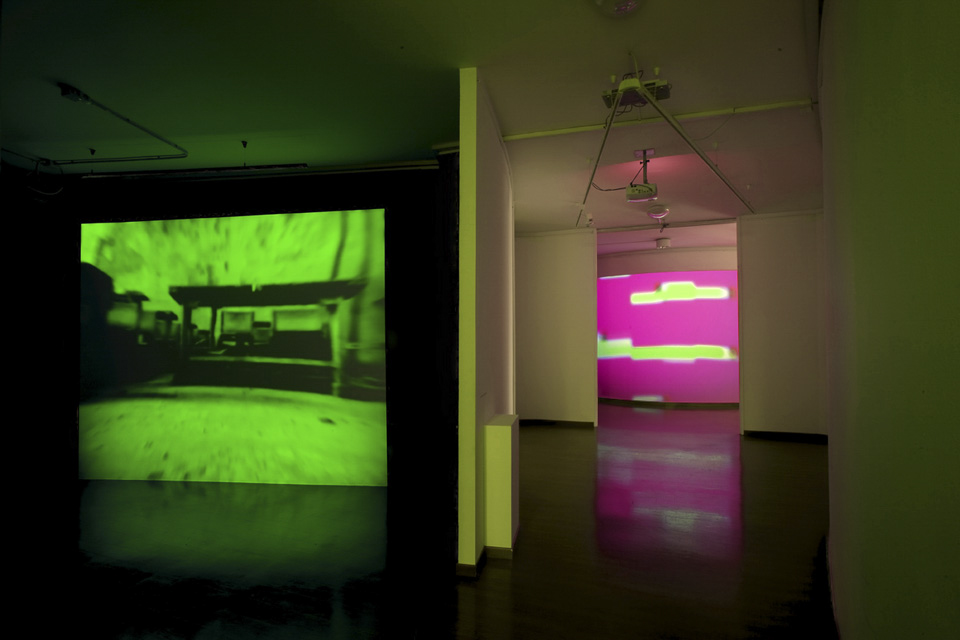
Deep Blue Ocean of Emptiness and Slow Brain
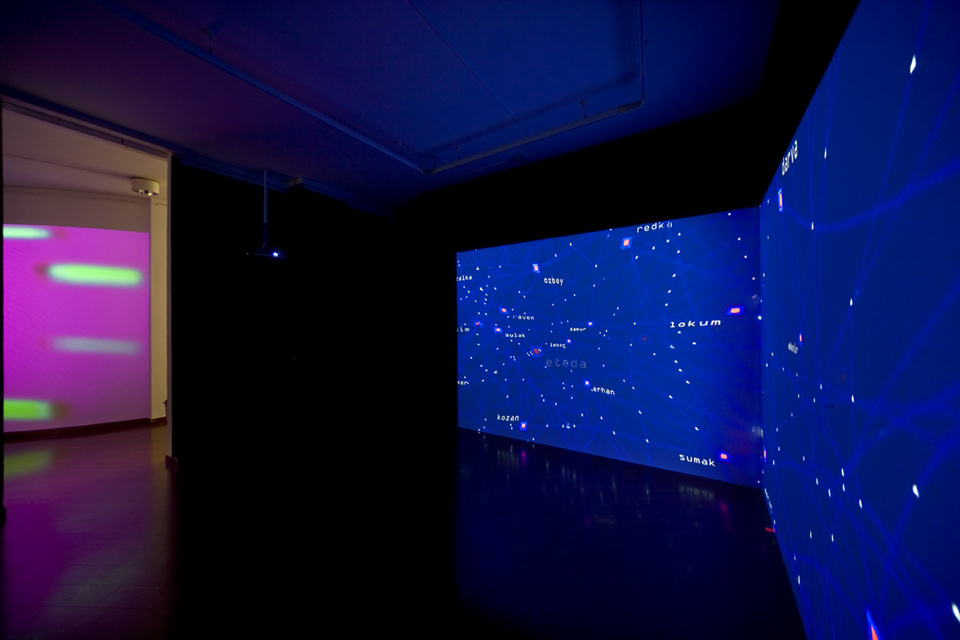
Slow Brain and Relational Domain
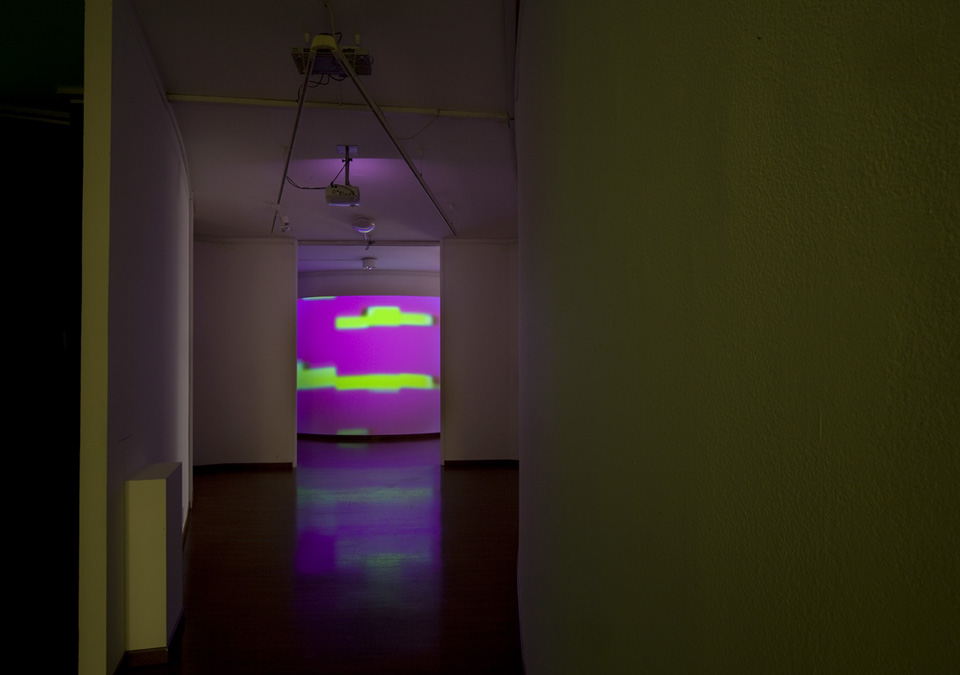
Slow Brain
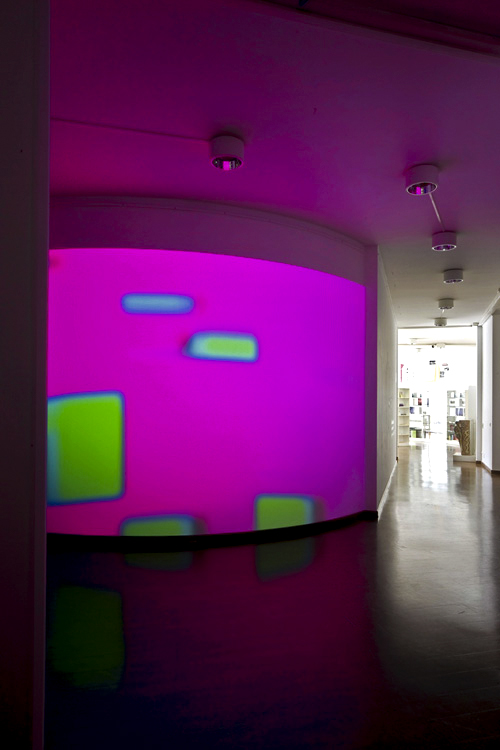
Slow Brain
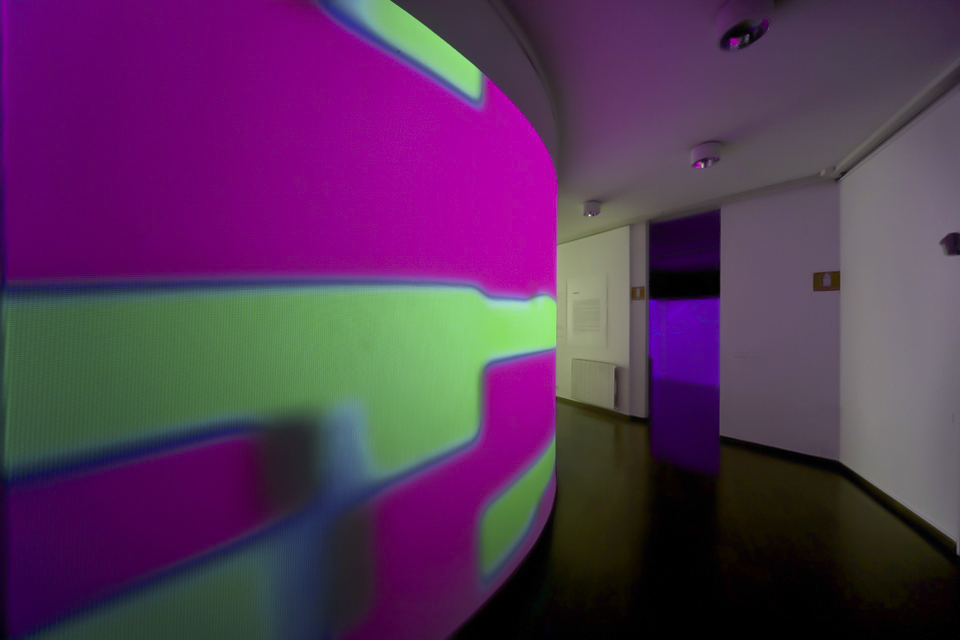
Slow Brain
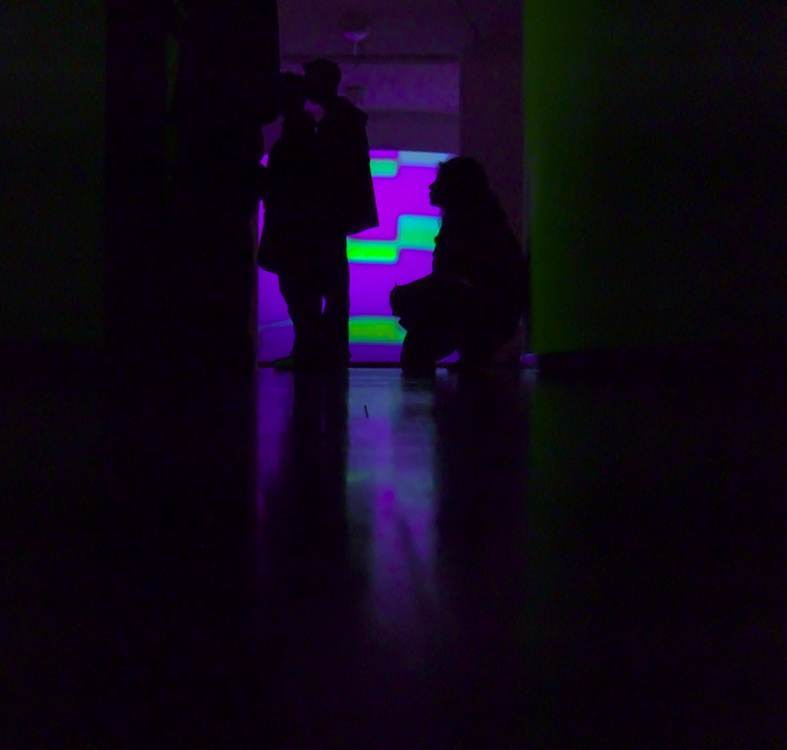
Slow Brain
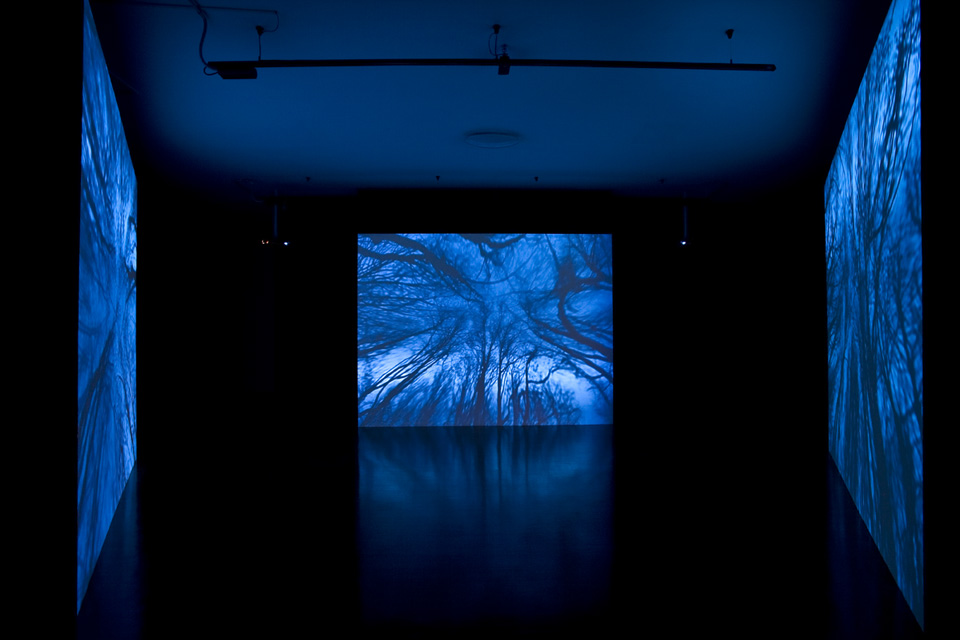
Tempo Universale
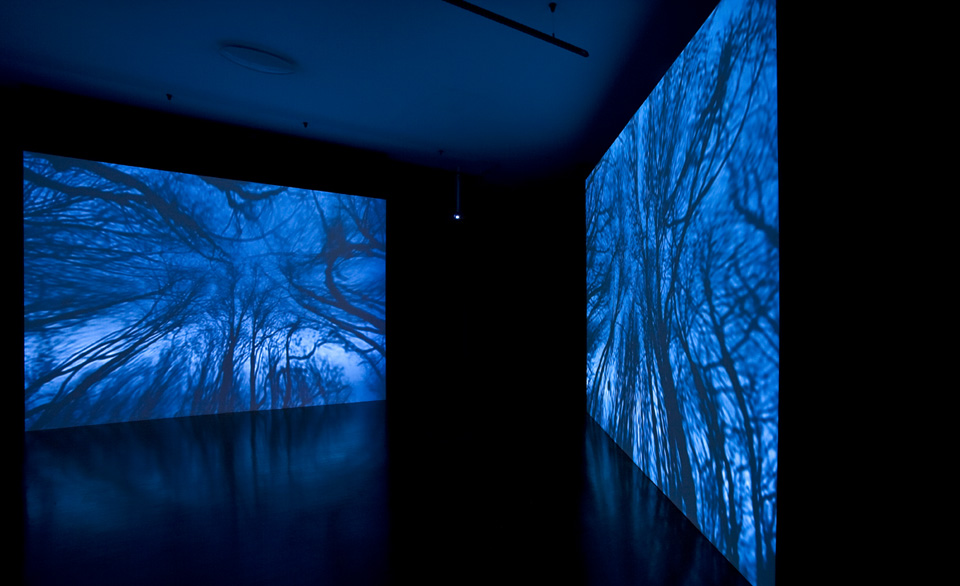
Tempo Universale
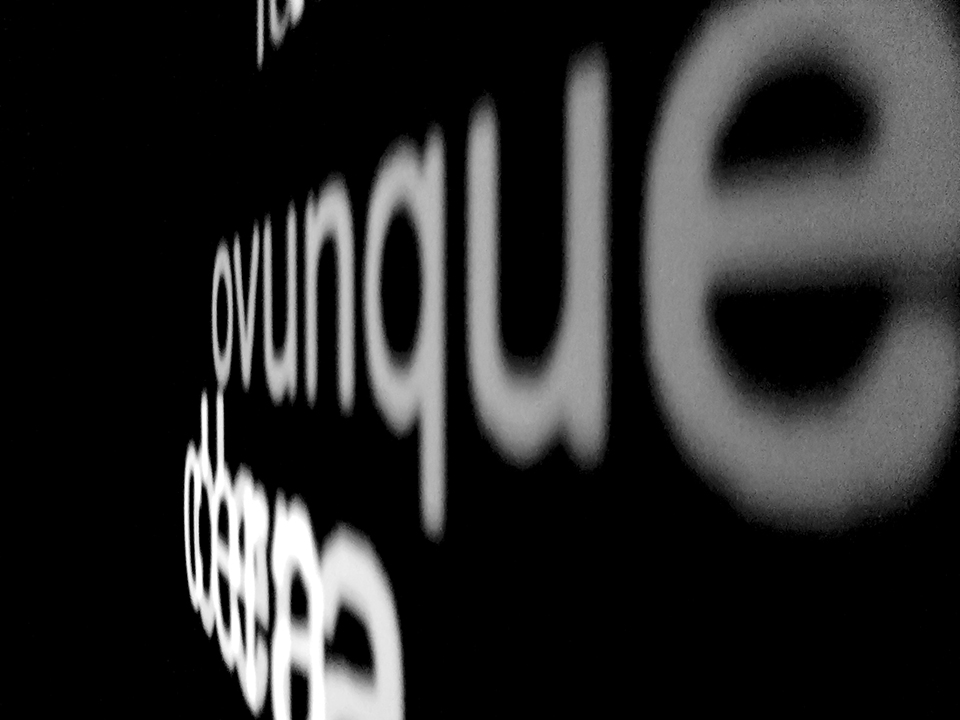
Altered State
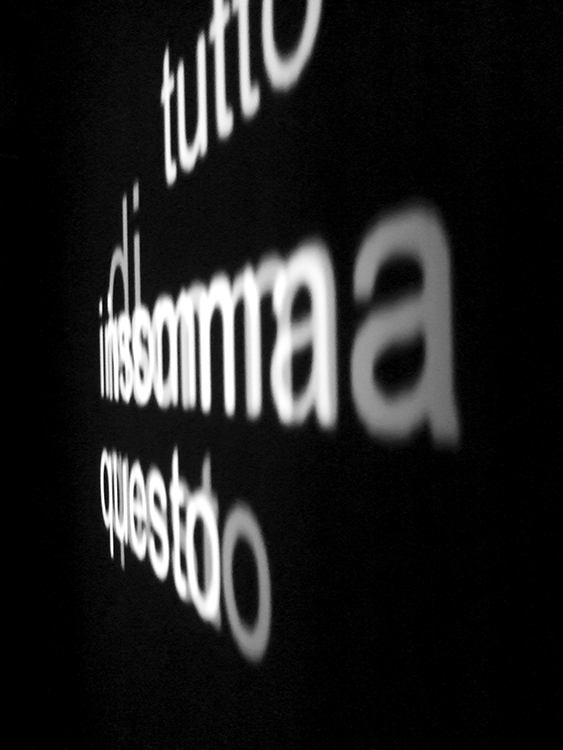
Altered State
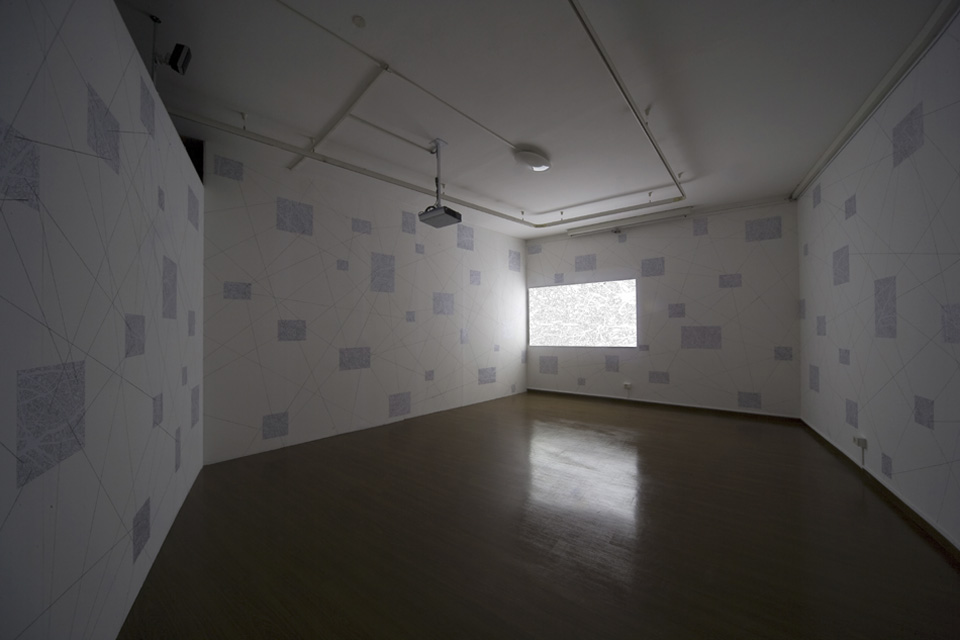
The Effort to Recompose my Complexity
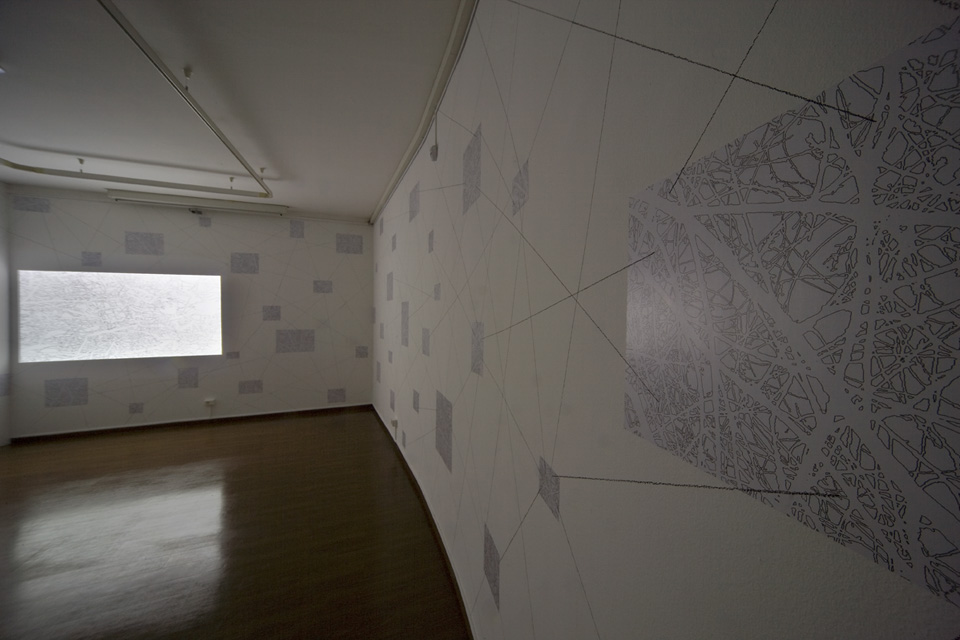
The Effort to Recompose my Complexity
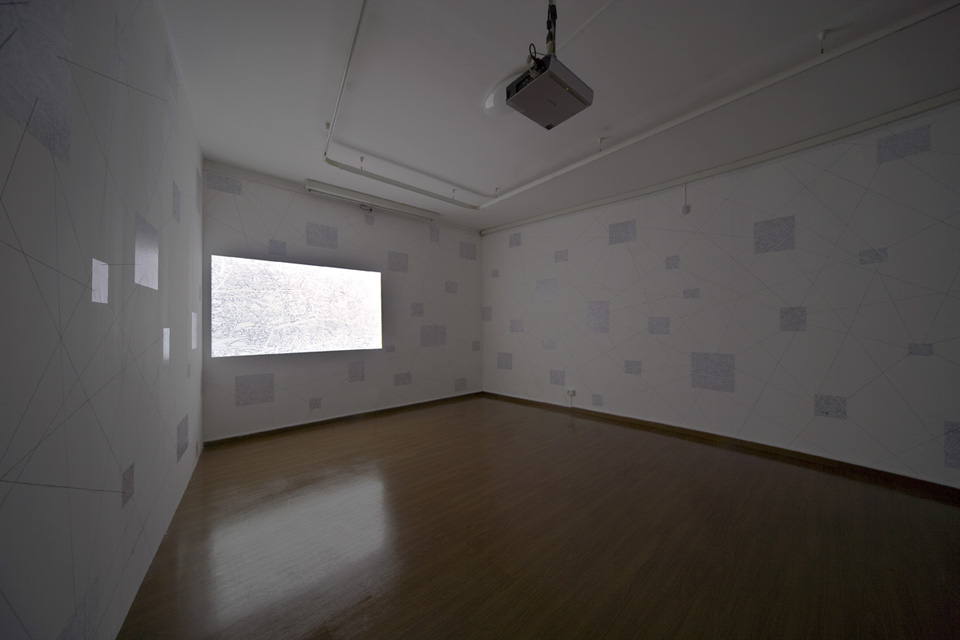
The Effort to Recompose my Complexity (Tutte le foto sono di M. Guariglia e M. Broggini)
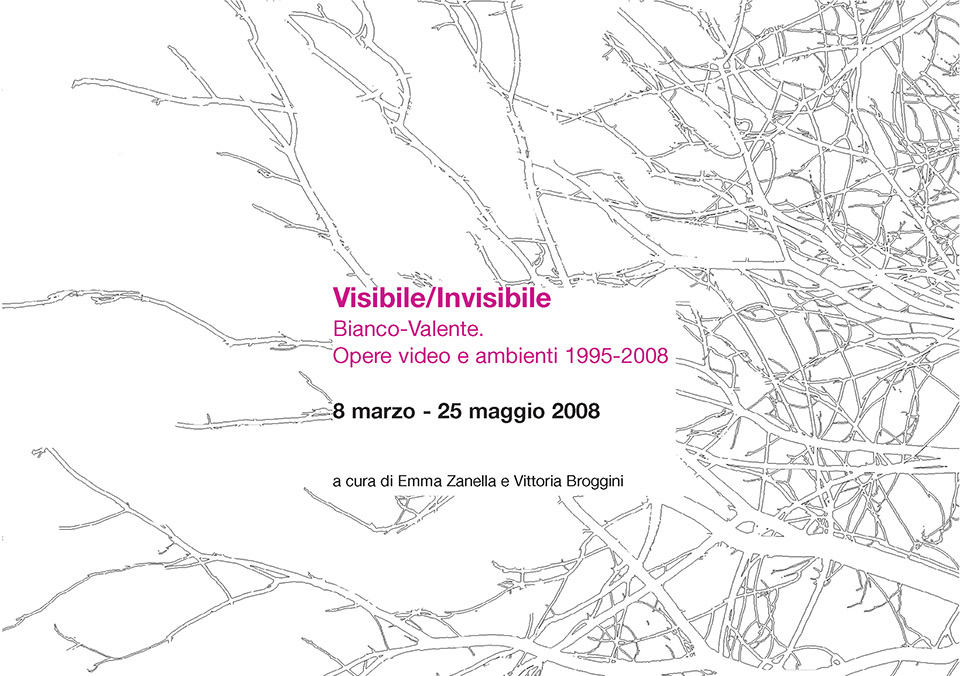
L'invito della mostra / The Invitation Card of the Exhibition
Recensioni / Reviews
- Bianco-Valente GAM - Civica Galleria d'Arte Moderna, Gallarate (VA), di Matteo Galbiati, EspoArte n. 53 giugno-luglio 2008 (Pdf)
- Bianco-Valente - Visibile Invisibile, Gam, Gallarate, Exibart.TV, 30 aprile 2008 (Video) (Link)
- Bianco e Valente, di Francesca Guerisoli, Artkey, 20 marzo 2008 (Link) (Jpg)
- Bianco e Valente, Gam di Gallarate, Varese, by Francesca Guerisoli, Teknemedia.net, 20 marzo 2008 (link)
Dalla simulazione alla relazione di Bruno Di Marino
Se in passato il rapporto tra arte e scienza si manifestava attraverso un sistema di equivalenze simboliche – cosmiche (astrologia), spirituali (alchimia) – dal XX secolo in poi il processo di elaborazione estetica nella sua relazione con l'immaginario scientifico, ha assunto altri connotati: per esempio la riflessione su natura e artificio è andata oltre, configurandosi come una sfida tra reale e virtuale, dove il virtuale si è spesso sostituito interamente al reale; il mito settecentesco della macchina che prende il posto dell'uomo, si è rovesciato nell'uomo (l'artista) che si trasforma in macchina, attraverso protesi, estensioni, interfacce digitali. Per non parlare dell'evoluzione delle neuroscienze, che hanno spalancato all'arte incredibili orizzonti: pensiamo al rapporto tra i processi di formazione delle immagini interiori, alle modificazioni degli stati di coscienza e la creazione di composizioni astratte, dalla pittura al cinema strutturale alle arti elettroniche.
L'opera d'arte nei tempi antichi era un riflesso, una traduzione per immagini simboliche del sapere scientifico. Oggi – nel suo dover/poter utilizzare le nuove tecnologie – la creazione diviene essa stessa (una) scienza. Il dispositivo artistico coincide con quello scientifico. L'osservazione delle leggi che regolano la fisica o la chimica, trasposte all'interno dell'orizzonte estetico, sono fonte d'ispirazione metodologica, concettuale, formale.
Il lavoro di Bianco-Valente s'inserisce nel solco della tradizione antica, dove l'arte diviene metafora, ma anche racconto, illustrazione critica della conoscenza scientifica. Del resto alla scienza ortodossa, che si ostina a spiegare i fenomeni naturali esclusivamente attraverso formule matematiche, scomponendo all'occorrenza un problema complesso in sottoproblemi più semplici, Bianco-Valente contrappongono la metodologia della simulazione, la disciplina che studia la complessità, ricollegandosi direttamente ad un sapere pre-moderno, quando appunto l'astrologia – arte di mettere in relazione la posizione dei pianeti nel cielo con gli accadimenti terrestri – era considerata scienza. Ma le loro opere si profilano, al contempo, come paradigma di un nuovo rapporto strutturale di scambio, tra rappresentazione e funzionamento del pensiero. A differenza di altri artisti contemporanei, tuttavia, il duo partenopeo costruisce immagini “volatili”, fluide, mnemoniche e immateriali che sono, prima di tutto, emozionali; trasmettono cioè allo spettatore un vero e proprio benessere estetico psicofisico diffuso, prima ancora che parlare al suo cervello.
Le installazioni allestite per questa personale, insieme agli altri lavori non presenti, vanno letti come tanti capitoli di una graduale evoluzione del loro fare artistico, non in direzione di una estetizzazione della scienza, quanto piuttosto di una scientificazione dell'arte, sintetizzabile in alcuni concetti fondamentali, ovviamente non ordinabili cronologicamente:
a) simulazione (Breathless , Volatile)
b) alterazione (Altered State , Slow Brain)
c) narrazione (Deep Blue Ocean of Emptiness , Aria , Untitled)
d) ripetizione (Uneuclidean Pattern , I Should Learn from You)
e) relazione (Relational Domain , Tempo universale)
Il rapporto di scambio tra la macchina e l'uomo, tra il dispositivo elettronico e il contenuto poetico, può essere regolato tanto dalla regola quanto dal caso. Sia Volatile che Breathless , così come Machine is Dreaming , sono installazioni incentrate sul processo di simulazione. In Volatile gli artisti hanno programmato il computer in modo da replicare, attraverso un gioco di punti luminosi, il volo degli uccelli in stormo (fenomeno frequente anche nelle grandi città), fissando alcune norme che regolano il processo di formazione delle immagini: ciascun punto luminoso deve cercarsi altri due compagni per muoversi insieme ad essi, ma senza né avvicinarsi né allontanarsi troppo. L'osservazione ornitologica diviene così il modello per un'astrazione proiettata nello spazio. Sia Breathless che Machine is Dreaming sono invece due installazioni sonore: nella prima la protagonista è la parola (in quanto voce, suono, timbro): un computer seleziona e legge in tempo reale – attraverso il suo microprocessore – poesie scritte dai due artisti; ma l'imperfezione e la primordialità di questa voce sintetica umanizzano la macchina più che meccanizzare la voce umana; nella seconda installazione, il computer ha invece il compito di produrre, attraverso l'elaborazione di complicati calcoli matematici, un suono piatto che somiglia al rumore del mare sulla battigia. La conseguenza di tutti questi lavori è una totale sovrapposizione tra il dispositivo scientifico e quello artistico, all'insegna di una reciproca simulazione.
Una particolarità di Machine is Dreaming è che la scheda madre del computer poggia su alcune compresse psicoattive; ciò non comporta effettive conseguenze sullo status del dispositivo, è solo un'azione concettuale, che tuttavia rafforza il paragone tra i circuiti elettronici della macchina e quelli neuronici dell'uomo. L'hardware, così come l'essere umano, è soggetto ad alterazioni, spesso originate da virus. Nell'opera di Bianco-Valente l'alterazione è un concetto strettamente legato a quello della simulazione: la videoinstallazione Slow Brain , ad esempio, traduce in immagini gli stati cerebrali alterati proprio dall'assunzione di sostanze psicotrope, che agiscono sulla corteccia cerebrale distorcendo la percezione della realtà. Su questo stesso tema è incentrato il video Altered State , totalmente composto da frasi tratte dai diari del chimico svizzero Albert Hofmann che – dopo aver casualmente scoperto l'LSD – decise di sperimentarlo per primo su se stesso, annotando pagine e pagine sotto l'effetto di questa sostanza. Il risultato è un lettering rapido, quasi illeggibile, di parole, pensieri, associazioni, una sorta di ipertesto fortemente poetico in cui confluiscono scienza, arti visive e letteratura, non lontana in fondo da quell'estetica del frammento decostruito e assemblato ( cut-up ), teorizzata da uno “psicoscrittore” come William S. Burroughs.
É impossibile parlare di narrazione in senso stretto per Bianco-Valente, anche se le avventure della mente o la visualizzazione degli stati alterati di coscienza sono, a loro modo, racconti. É evidente che i lavori monocanale – con un loro inizio e una loro fine ben definita, visibili anche all'interno di rassegne video – rappresentano, meglio delle installazioni, l'attitudine narrativa dei due artisti. Pensiamo all'aula scolastica scandagliata in piano-sequenza dalla videocamera come se fosse un relitto sottomarino di Deep Blue Ocean of Emptiness : sembra che gli alunni abbiano lasciato questo spazio solo il giorno prima, mentre invece, a giudicare dall'arredo dei banchi e delle sedie, sono passati alcuni decenni. E – per quelle strane combinazioni che legano le opere di Bianco-Valente anche a distanza di tempo – non è forse possibile che i bambini di questa classe "fantasma" siano gli stessi che comparivano in subliminale successione nel video del 1996 Mind Landscapes cantando una filastrocca? Non lo sapremo mai. Non lo sanno neppure gli artisti, eppure è affascinante pensare che, col tempo, si sia creato, casualmente, un cortocircuito narrativo e anche mnemonico.
“Tutti noi vorremmo essere trasparenti / ma vogliamo che nessuno ci conosca”, questo verso di Alda Merini è il punto di partenza per il brevissimo video Aria , concepito originariamente per essere fruito sui display dei telefoni portatili della Nokia. L'immagine di una falena che gira intorno ad una lampadina accesa, attratta dalla luce ma respinta dal suo involucro di vetro, simboleggia lo scarto tra l'essere e l'apparire, il desiderio di entrare in contatto con l'altro e al tempo stesso la paura di mettere a nudo la nostra vera anima. Ancora una volta l'opera – che, in questo caso, si articola attraverso una forma narrativa minima – nasce dall'osservazione della natura e della psiche umana.
Ma è anche il dispositivo per il quale nasce Aria , il microschermo di un cellulare, a illuminarci su un altro aspetto della poetica di Bianco-Valente, la riflessione – anch'essa desunta dalle scienze naturali – sull'infinitamente grande e sull'infinitamente piccolo. Pensiamo allora ad un altro lavoro, Untitled , forse il più vecchio in ordine di tempo. L'immagine elettronica ci mostra la sagoma di una persona che cammina su un fondo rosso intenso: a ben vedere si tratta di una delle poche presenze umane che possiamo scorgere nelle opere installative dei due artisti. Ma, sarà poi davvero umana? E, sarà poi davvero una presenza o non è – come negli altri casi – un'immagine tutta mentale? Il video è incluso nella collezione permanente del Palazzo delle Papesse a Siena ed è presentato all'interno di un piccolissimo monitor incassato nella parete rocciosa, un francobollo di luce che emerge nell'oscurità più totale (una dimensione immersiva nel senso più puro del termine) e che richiama lo spettatore, un po' come la lampadina attrae la falena.
Per Bianco-Valente il dispositivo elettronico può essere esposto, denudato, sezionato, reso visibile nei suoi circuiti essenziali ( Breathless ), oppure nascosto, mimetizzato, smaterializzato ( Untitled ). Visibile e invisibile, come il titolo di questa mostra. Ma nella loro opera le dimensioni non riguardano solo il formato delle immagini e dei supporti, bensì anche la grandezza dei soggetti, la loro trasparenza. I due artisti prediligono l'utilizzo di visioni microrganiche, da (ri)animare al suono di battiti, vibrazioni, scariche elettriche. Astrazioni naturali e pulsanti, che replicano la trama instabile del pixel. Entrambe unità minime di senso, vitali le prime, iconiche le seconde.
Il loro interesse per le scienze neurobiologiche, si mescola all'attrazione per i processi random , per i cicli naturali, come Uneuclidean Pattern , dove il simbolo del grano agitato dal vento allude al ciclo vitale; ancora una volta ci imbattiamo nel concetto di simulazione, cui si aggiunge però l'idea di temporalità e serialità, rafforzata sia dalla linea di scansione che compare nell'immagine, sia dal dispositivo a loop con cui il video è trasmesso. Ed è proprio questo quarto concetto, ricorrente nell'arte di Bianco-Valente, ovvero la ripetizione temporale, ad informare molti altri loro video, come l'installazione I Should Learn from You .
La consapevolezza quotidiana di vivere, agire e operare in un dominio relazionale, con la conseguente analogia che si stabilisce tra mente e universo, senso e destino, come può non orientare il lavoro (oltre all'anima) dell'artista? Come può non trasformare la sua prospettiva spazio-temporale? Viaggiare in posti non turistici, confrontarsi con realtà diverse dalla nostra, conoscere persone che percepiscono il tempo in modo diverso, tutto ciò muta profondamente anche parametri, modelli e significati della rappresentazione.
Nel 2001 Bianco-Valente hanno iniziato il progetto RSM , legato ai viaggi e alle influenze astrali, con l'intento di verificare su se stessi la veridicità di un'antichissima teoria astrologica/astronomica, ricodificata negli anni '70 ad opera dello studioso Ciro Discepolo, che postula dei cicli annuali a cui ogni essere vivente è imprescindibilmente legato e la possibilità, spostandosi sul globo terrestre al rinnovarsi di ogni ciclo, di influenzare gli avvenimenti futuri. RSM non è stato ancora formalizzato come opera, ma ha già ispirato alcuni loro lavori, come ad esempio Relational Domain (2005), installazione composta da due videoproiezioni ad angolo, allusione al legame sottile che unisce tutte le cose. I viaggi di Bianco-Valente non sono semplici performance intime, private, invisibili al pubblico, bensì una sorta di esercizio spirituale volto a tracciare mappe fisiche e mentali, riflessioni sul rapporto tra luogo e destino. In occasione dei loro compleanni, i due artisti - dopo elaborati calcoli ottenuti per mezzo di un software sul moto dei corpi celesti - raggiungono luoghi precisi del globo terrestre, per ottenere gli influssi astrali desiderati. Sono viaggi spesso impervi verso luoghi difficili da raggiungere, eppure necessari, non procrastinabili.
Tempo universale (2007) è un'altra videoinstallazione – stavolta articolata in tre proiezioni di grande formato – che affronta la dimensione relazionale. La visione in movimento di alberi ripresi dal basso che si stagliano contro il cielo all'imbrunire, è un richiamo al concetto di ramificazione e di corrispondenza tra scrittura celeste ed esperienza terrestre; ma questo lavoro sottolinea ancora una volta quanto l'essere umano sia inglobato in un sistema di relazioni visibili e invisibili: pur vivendo a latitudini diverse, condividiamo lo stesso cielo e tentiamo – attraverso dispositivi come la radio ad onde corte – di condividere anche lo stesso tempo.
I suoni che sentiamo in Tempo universale e che accompagnano questa specie di ossessivo scrutare il cielo, alla ricerca di segni e pianeti, sono infatti generati dalle radio a onde corte; un tipo di trasmissione che, grazie alla riflessione ionosferica, è in grado di propagarsi in tutto il mondo. Per restituire quest'idea di simultaneità temporale, Bianco-Valente hanno progettato un dispositivo sonoro, articolato in dieci canali dolby surround , con altrettanti altoparlanti posizionati sul soffitto. L'installazione diviene per lo spettatore il pretesto per compiere un'esperienza di tempo oggettivo globale. Percepire il suono del mondo restando fermo in un solo luogo, non ricorda un po' l' aleph di cui parla Borges nel suo omonimo racconto? Un punto da cui osservare contemporaneamente tutti i luoghi del pianeta.
Su questa linea si muoveranno anche i futuri lavori di Bianco-Valente. La coscienza di essere avvolti sempre e ovunque da onde elettromagnetiche (naturali e generate dall'uomo), sta spingendo i due artisti a trasformare il loro stesso corpo in una sorta di antenna, per metterlo in risonanza con le forme di energia vaganti nell'universo; allo stesso modo, creando una catena di esseri umani a forma di spirale, è possibile captare emissioni elettromagnetiche naturali provenienti da altri pianeti, come ad esempio Giove.
Dalla simulazione alla relazione e viceversa, come un cerchio che si ripete all'infinito, passando attraverso altri stadi (l'alterazione, l'articolazione narrativa, la ripetizione temporale); questo sintetico tracciato non va inteso come un vero e proprio percorso, è una delle tante possibili letture di una ciclica esplorazione sulla natura delle cose, una pura suggestione critica dettata dalla visione congiunta della decina di installazioni presenti in mostra.
Dietro ciascun'immagine, dietro ciascun suono di Bianco-Valente, si cela una profonda riflessione scientifica ed un'attenta elaborazione estetica, ma il loro approccio resta sostanzialmente caldo : tanto è vero che per poter leggere e comprendere una loro opera non è indispensabile aver accesso alle teorie scientifiche che l'hanno ispirata. É sufficiente la capacità di emozionarsi e di naufragare nel profondo oceano blu della memoria, vibrando all'unisono con i suoni del cosmo.
From Simulation to Relation by Bruno Di Marino
If in the past the relationship between art and science manifested itself through a system of symbolic – cosmic (astrology) and spiritual (alchemy) equivalences – from the 20th century onward, the process of aesthetic elaboration in relation to the scientific imagination assumed other connotations: for example, the reflection on nature and artifice went even further, evolving into a challenge between the real and the virtual, where the virtual often totally replaced the real; the 18th-century myth of the machine replacing man was inverted, and man (the artist) was transformed into a machine through prostheses, extensions, and digital interfaces. Not to mention the evolution of neurosciences, that have opened up incredible horizons to the world of art: just think of the relationship between the processes that form interior images, changing states of consciousness, and the creation of abstract compositions, from painting to the structural cinema of electronic arts.
In ancient times, the work of art was a reflection, a translation of scientific knowledge into symbolic images. Today – with onset of the duty/ability to use new technologies – creation in itself has become a science. The artistic device coincides with the scientific one. The observation of the laws that regulate physics or chemistry, transposed within aesthetic horizons, are the source of methodological, conceptual, and formal inspiration.
The work of Bianco-Valente fits neatly into the category of ancient tradition, where art becomes metaphor, but also an account or critical illustration of scientific knowledge. On the other hand, Bianco-Valente contrast the methodology of simulation with orthodox science, the discipline that studies complexity with the discipline that persists in explaining natural phenomena exclusively through mathematical formulas and breaking down a complex problem into easier sub-problems. The contrast is achieved by reconnecting directly to a pre-modern knowledge - to a time when astrology, the art of drawing relationships between the position of the planets in the heavens and events on earth, was considered a science. But at the same time, their works are classified as a paradigm of a new structural relationship of exchange between the representation and functioning of thought. However, in net contrast to other contemporary artists, this Neapolitan duo constructs “volatile”, fluid, mnemonic, and immaterial images that are, above all, emotional; in other words, they succeed in transmitting a diffuse aesthetic, psycho-physical sense of well-being to the spectator even before they speak to his brain.
The installations in this personal show, together with the other works not present, should be interpreted as many chapters in the gradual evolution of their artistic activity, not towards an aesthetization of science, but rather towards a “scientification of art” that can be synthesized in a few fundamental concepts that cannot, for obvious reasons, be ordered chronologically:
a) simulation ( Breathless , Volatile )
b) alteration ( Altered State , Slow Brain )
c) narration ( Deep Blue Ocean of Emptiness , Aria , Untitled )
d) repetition ( Uneuclidean Pattern , I Should Learn from You )
e) relation ( Relational Domain , Tempo universale )
The ratio of exchange between machine and man, between the electronic device and the poetic content, can be regulated as much by rules as by chance. Both Volatile and Breathless , as is also Machine is Dreaming , are installations focused on the process of simulation. In Volatile the artists programmed the computer to replicate the flight of a flock of birds (a frequent phenomenon even in large cities) via luminous light points, fixing some rules that regulate the formation process of the images: each light point must seek another two companions and move in relation to them, but without ever moving too close or too far away. The ornithological observation thereby becomes a model for an abstraction projected into space. Instead, both Breathless and Machine is Dreaming are audio installations: in the first the protagonist is the word (as voice, sound, timbre): a computer selects and reads in real time – through its microprocessor – poems written by both artists; but the imperfection and rawness of this synthetic voice, humanizes the machine more than it mechanizes the human voice; in the second installation, the computer must produce, through the elaboration of complicated mathematical calculations, a flat sound that resembles the sound of the sea on the shore. The consequence of these works is a total overlapping of the scientific device and the artistic one, or the representation of reciprocal simulation.
One peculiarity of Machine is Dreaming is that the motherboard of the computer rests on some mood-altering pills. This does not have definitive consequences on the status of the device, but is only a conceptual statement that does, however, reinforce the comparison between the electronic circuit of the machine and the neuronic one of man. In this way, the hardware, like a human being, is subject to alterations often caused by viruses. In Bianco-Valente's work, alteration is a concept strictly linked to that of simulation: the video installation entitled Slow Brain , for example, takes cerebral states altered while under the effects of psychotropic substances that act on the cerebral cortex, distorting the perception of reality, and translates them into images. This is also the theme of the video Altered State , which is consists totally of phrases from diaries belonging to the Swiss chemist Albert Hofmann who – after having discovered LSD by chance – decided to experiment it on himself first, writing pages and pages of notes while under the effect of this substance. The result is a rapid, almost illegible lettering of words, thoughts, associations, a sort of extremely poetic hypertext in which science, visual arts, and literature converge. All in all, it actually does not differ much from the aesthetics of the fragment cut-up and reassembled theorized by a “psycho-writer” like William S. Burroughs.
For Bianco-Valente, it is impossible to speak of narration in the strict sense of the word, even if the adventures of the mind or the visualisation of altered states of consciousness are, in their own way, tales. It is evident that the mono-channel works – with their well-defined beginning and end, visible even as part of a video exhibition – represent the narrative attitude of the two artists better than the installations do. Just consider the classroom panned in slow-sequence by the video camera as if it were an underwater shipwreck in Deep Blue Ocean of Emptiness: it looks like the students just left this space the day before, while instead, judging from the style of the desks and chairs, at least a few decades must have passed. And – for those strange combinations that link the works of Bianco-Valente even decades later – isn't it possible that the children of the “ghost” class are the same who appeared singing a nursery rhyme in subliminal succession in the 1996 video entitled Mind Landscapes? We will never know for certain. Even the artists don't know, and yet it is fascinating to think that, with time, a narrative and even mnemonic short circuit has been randomly created.
“All of us would like to be transparent / but we don't want anyone to know us,” is the verse by Alda Merini that serves as the starting point of the very short video entitled Aria, originally conceived to be used on the display of portable Nokia telephones. The image of a moth fluttering about a brightly lit bulb, attracted by the light but repelled by its glass globe, symbolises the barrier between being and appearing, the desire to enter into contact and at the same time the fear of baring our true souls. Once again the work – which in this case is articulated through a minimally narrative form – is born of the observation of nature and the human psyche.
But it is the same device that gave birth to Aria, the micro-screen of a mobile phone, that illuminates us on another aspect of the poetry of Bianco-Valente, the reflection – which is also inferred from natural sciences – on the infinitely large and the infinitely small. So let us think of another work, Untitled , perhaps the oldest in the chronology. The electronic image shows us the outline of a person walking against an intense red background: upon closer inspection, it is one of the few humans to be seen in the installations of these two artists. But, is it truly human? And, is it really a presence or is it - as in other cases – a totally mental image? The video is included in the permanent collection of Palazzo delle Papesse in Siena and is displayed on a tiny monitor built into the rocky wall, a stamp-sized light that beckons to the spectator through total darkness (an immersive dimension in the purest sense of the word), much as the light bulb attracts the moth.
For Bianco-Valente, the electronic device can be exhibited, bared, dissected, and made visible in all its essential circuitry ( Breathless ), or hidden, camouflaged, or dematerialized ( Untitled ). Visible and invisible, like the title of this show. But in their works, the dimensions do not regard only the format of the images and supports, but also the dimensions of the subjects and their transparency. The two artists prefer using micro-organic visions to be (re)animated to the sound of beats, vibrations, or electrical shocks. Natural and pulsating abstractions that replicate the wavering fabric of the pixel. Both being minimal units of sense: the former are alive, while the latter are iconic.
Their interest in neurobiological sciences is mixed with an attraction for random processes, for natural cycles, like Uneuclidean Pattern , where the symbol of grain waving in the wind alludes to the life cycle; once again we run into the concept of simulation, together with the idea of temporality and seriality, reinforced by the scan line that appears in the image and the loop device used to transmit the video. And it is precisely this fourth concept of temporal repetition that is often a recurring element in the art of Bianco-Valente, giving form to many other videos, like in the installation I Should Learn from You.
How can the daily awareness of living, acting, operating in a relational domain with the consequential analogy that forms between mind and universe, sense and destiny, not possibly orient the work (as well as the soul) of the artist? How can it not transform his spatial-temporal perspective? Travelling off the beaten track, comparing realities different from ours, meeting people who experience a different perception of time: all this profoundly changes the parameters, models, and meanings of the representation.
In 2001, Bianco-Valente initiated the RSM project, linked to travels and astral influences, with the intention of using themselves to test the veracity of an ancient astrological/astronomical theory that was reworked during the 1970s by the scholar Ciro Discepolo, who hypothesized that the relationship between the annual cycles to which every living being is unavoidably linked and the possibility of moving over the earth's surface at the renewal of each cycle may influence future events. RSM has not yet been formalized as a work, but has already inspired many of their works, like Relational Domain ( 2005 ), an installation of two corner video projections, alluding to the fine thread that unites all things. The travels of Bianco-Valente are not merely real-time, private performances invisible to the public, but rather a sort of spiritual exercise aimed at tracing physical and mental maps, reflections on the relationship between location and destiny. For their birthdays, the two artists – after having carried out calculations via software that models the motion of heavenly bodies – travel to precise points on the Earth to obtain the desired astral influence. These are often impractical journeys towards destinations that are difficult, yet of the utmost necessity. Their arrival cannot be postponed.
Tempo universale (2007) is another video installation – this time articulated in three, large format projections – intended as an encounter with the relational dimension. The vision of moving trees shot from below as they dance against the twilight sky evokes the concept of ramification and correspondence between heavenly writings and earthly experience; but this work once again underlines the extent to which human beings are assimilated in a system of visible and invisible relations: even though we live at different latitudes, we share the same sky and attempt – through devices like the short-wave radio – to share the same time as well.
The sounds we hear in Tempo universale and that accompany this sort of obsessive observation of the sky to discover signs and planets are in fact generated by short-wave radios; this is a type of transmission that, thanks to ionospheric reflection, is capable of being diffused throughout the world. In order to give the sensation of temporal simultaneity, Bianco-Valente have designed an audio device with ten Dolby surround channels with another ten loudspeakers positioned on the ceiling. For the spectator, the installation becomes an opportunity to experience objective global time. Perceiving the sound of the world while standing still: doesn't it sound a bit like the aleph that Borges describes in his novel of the same name? One point from which all points on the planet can be observed contemporaneously.
This is the line that future works of Bianco-Valente continue to follow. The awareness of being enveloped always and everywhere by electromagnetic waves (whether natural or man-made) is pushing the two artists to transform their own bodies into antennae, so to speak, syntonizing them to resonate sympathetically with the forms of energy dispersed throughout the universe. In the same way, the creation of a spiralling chain of human beings makes it possible to capture natural electromagnetic emissions from other planets, like Jupiter for example.
From simulation to relation and vice-versa, like a vicious circle that endlessly repeats itself, passing through various stages (alteration, articulated narration, temporal repetition); this outline should not be taken as an absolute itinerary, but rather as one of the many interpretations of a cyclical exploration of the nature of things, a purely critical suggestion inspired by the concurrent viewing of the dozen or so installations present in this show.
Behind each image, behind each sound used by Bianco-Valente, lies a profound scientific reflection and a scrupulous aesthetic elaboration, but the approach remains essentially warm : in fact, in order to read and comprehend one of their works, it is not necessary to understand the scientific theories that inspired it. The capacity to abandon yourself to your emotions and let yourself be swallowed up by the deep blue ocean of memories, vibrating in unison with the voice of the cosmos should suffice.
home | bio-biblio | texts/testi | video |